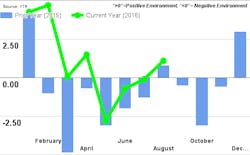Are the Good Times Really Over for Good?
As the country prepares to elect a new U.S. President, the current conditions for shippers are at a low but positive reading of 1.1, according to the FTR Shippers Conditions Index. Enjoy it while it lasts, as the transportation forecasting firm believes that shipping rates will increase soon as available capacity will be negatively impacted by economic conditions while a new regulatory drag will affect the trucking industry in 2017. That current wave of new regulations is not expected to be short-lived, but rather will continue at least through 2019, FTR predicts, which could see the Shippers Conditions Index drop to new lows.
The Shippers Conditions Index is a compilation of factors affecting the shippers transport environment. Any reading below zero indicates a less-than-ideal environment for shippers. Readings below -10 signal conditions for shippers are approaching critical levels, based on available capacity and expected costs.
“Shippers are still able to take advantage of a moderately loose trucking environment,” notes Jonathan Starks, COO at FTR, “largely due to the continued weakness in economic and freight conditions, especially in manufacturing and mining. In addition, shippers continue to benefit from the fuel environment, which has remained subdued, helping maintain cost reductions. Earlier this year, a spike in fuel prices seemed a distinct possibility. Now, a stable pricing environment seems the mostly likely scenario. That means that costs won’t fall significantly, but neither should fuel costs surge higher. This makes driver wages one of the key items to understand going into 2017. Shippers that understand how to best utilize a drivers time will be able to take significant advantage of that process to help drive better rates during a time in which the market may once again see 2014-like surges in prices.”
Meanwhile, according to the Cass Freight Index, a monthly report from Cass Information Systems that tracks shipment activity, overall shipment volumes in September were weak in most transportation modes, with increased levels of volatility as all levels of the supply chain attempt to reduce their inventory levels. Shipment volumes in September were 3.1% lower than the same month in 2015, representing the 19th straight month of year-over-year decline.
“The bottom line,” notes Donald Broughton, managing director and senior transportation analyst with Avondale Partners, “is the industrial recession in the U.S. that began in March 2015 continues to weigh on overall volumes.

